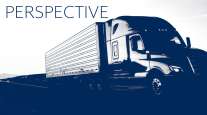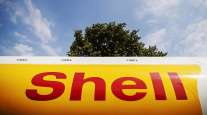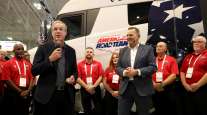Features Editor
RNG Seen as Near-Term Answer to Trucking’s Emission Hurdles
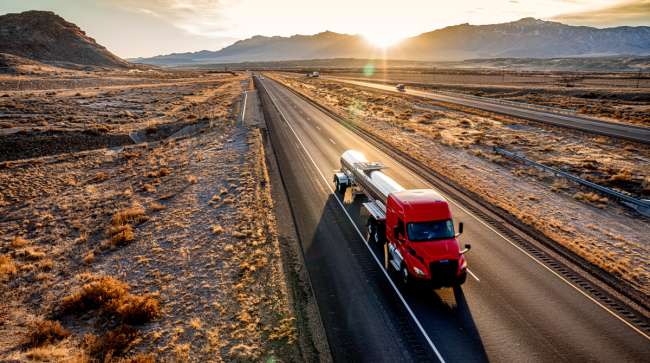
[Stay on top of transportation news: Get TTNews in your inbox.]
NASHVILLE, Tenn. — Could the future of carbon-negative trucking be closer than we think?
At the 2024 Management Conference & Exhibition Oct. 13, a panel of industry experts convened to explore how renewable natural gas might revolutionize fleet emissions, and what it will take to get there.
Marty Tufte, corporate fleet director with WM, stated the “regulatory maze” of federal mandates concerning cleaner fuel technology today is uncertain at best.
“Being in the fleet for most of my career, I can tell you that the one thing [fleets] need is a strategy and a plan, and the way the current regulations are, it is very difficult to do,” explained Tufte, who is also chair of the Transport Project, an organization promoting decarbonization efforts in the transportation sector.
One segment primed for growth in the RNG space is the longhaul freight market, said Matthew Spears, executive director of global regulatory affairs with Cummins Inc. He explained that with the certification of the X15N engine this summer, the company believes it’s well-positioned to meet the increasing environmental, social and governance pressures that companies are facing. He expressed optimism about this solution, indicating that Cummins feels confident about its potential in the market.
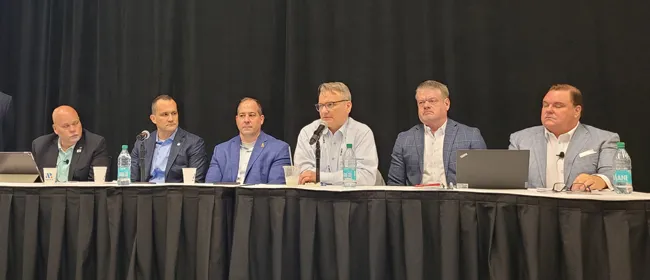
From left, Marty Tufte, corporate fleet director with WM; Ryan Bankerd, director of sustainability, UPS corporate affairs; Matt Copot, vice president of fleet management for Saia LTL Freight; Matthew Spears, executive director of global regulatory affairs with Cummins Inc; Eric Bippus, executive vice president sales and systems engineering for Hexagon Agility; Brett Lindsay, vice president of sales national accounts, Clean Energy. (Mike Freeze/Transport Topics)
Spears continued that RNG would make sense for fleets that find it difficult to transition toward battery electric.
“Renewable natural gas is here today. The engines are here and they’re certified to the standards today,” he said. “So, if we want to make improvements to the environment and try to address these climate change issues, we should be taking more advantage of what’s available today rather than look 10, 20 years into the future.”
Matt Copot, vice president of fleet management for Saia LTL Freight, concurred that RNG is not a “gap” technology between diesel and electric battery fleet usage, but rather a ready-made source with infrastructure and industry partnership. To have a successful transition, education is key.
Copot also emphasized the importance of collaboration in the transition to RNG vehicles. He noted that success requires involvement from OEMs, suppliers and internal training staff to educate both operators and technicians on the new technology.
“We’ve learned along the way that it takes our OEMs, our willing suppliers, our internal training staff to help the operators understand how these vehicles run as well as our technicians,” he said. Copot added that implementation has improved as operators have become more comfortable with the vehicles, which share similarities with traditional internal combustion engines. This familiarity, along with necessary certifications, has contributed to a smoother adoption process.
Saia ranks No. 18 on the Transport Topics Top 100 list of the largest for-hire carriers in North America.
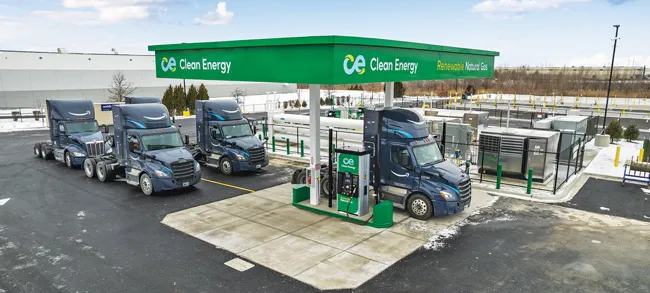
Amazon trucks refuel at a Clean Energy RNG station in Chicago. (Clean Energy)
From a total cost of ownership objective, Ryan Bankerd, director of sustainability, UPS corporate affairs, said his fleet, like WM and Saia, has been fuel agnostic, and using a source like RNG makes good financial and environmental sense.
“With the technology improvements, you get the TCO that makes sense,” Bankerd said. “When we integrated RNG in our fleet, it was difficult at first, but the industry has benefited from our experience and hard conversations with our suppliers, and right now, with the TCO, the environmental benefits and integration into the fleet, RNG makes good business sense.”
UPS ranks No. 1 on TT’s Top 100 for-hire list.
From the maintenance perspective, Tufte stressed the importance of educating technicians about the benefits of working with natural gas vehicles. He highlighted that these vehicles lack the high-maintenance diesel particulate filter and selective catalytic reduction emissions control systems found in diesel engines. This difference, Tufte explained, significantly reduces maintenance requirements.
McLeod Software CEO Tom McLeod explores the potential for artificial intelligence to boost efficiency and build resilience. Tune in above or by going to RoadSigns.ttnews.com.
“Compared to what we would need for maintenance from natural gas today, it is dramatically different,” he said.
So, there is a great need to familiarize technicians with the technology, dispel any apprehensions, and help them recognize the relative simplicity of natural gas systems. WM, which employs more than 3,500 in-house technicians, has made this education a priority in its transition to RNG vehicles.
Eric Bippus, executive vice president of sales and systems engineering for Hexagon Agility, an RNG solutions provider, noted that providing dependable service for fleets is and has been instrumental in the growth of CNG over the last eight years, and it’s vital to help the customer along the transition.
“We’ve seen a huge focus on serviceability,” he said. “It’s easy to get a fleet into the technology that can give them a great deal, but if they can’t operate that effectively and their truck is up and running, we’ll never get a second sell. We’ll never see them again.”
Bippus added that when speaking to fleets that are considering RNG and other sources like electrification, he lays out the differences.
Want more news? Listen to today's daily briefing above or go here for more info
“We can put an EV on the road that can do 300 miles easily. It’s going to be very expensive and there’s going to be a lot of downtime in between,” Bippus said. “So we focus on the user experience and allowing the fleet to operate the way they do today on a one-for-one exchange and that’s only natural gas that can do that.”
Brett Lindsay, vice president of sales national accounts at Clean Energy, stated that using biofuels is very effective for fleets to reduce Scope 1 emissions (fleet vehicles running on fossil fuels) and Scope 3 emissions for the fleet’s shipping customer (greenhouse gas emissions that occur from activities outside).
He explained that emissions from the combustion of biofuels are biogenic CO2 and are reported outside of Scope emissions, providing for some fleets a 90-98% reduction in emissions. However, he cautioned that while biofuels, like biodiesel and renewable diesel, are used in existing diesel engines, they do have limitations.
“Emission targets cannot be achieved with those biofuels alone,” he said. “Relying on only one biofuel creates policy, market and cost risks for a fleet’s emissions strategy.”
Lindsay added that RNG enables fleets to expand, enhance and diversify their emissions strategy while improving Scope reporting for shippers.




